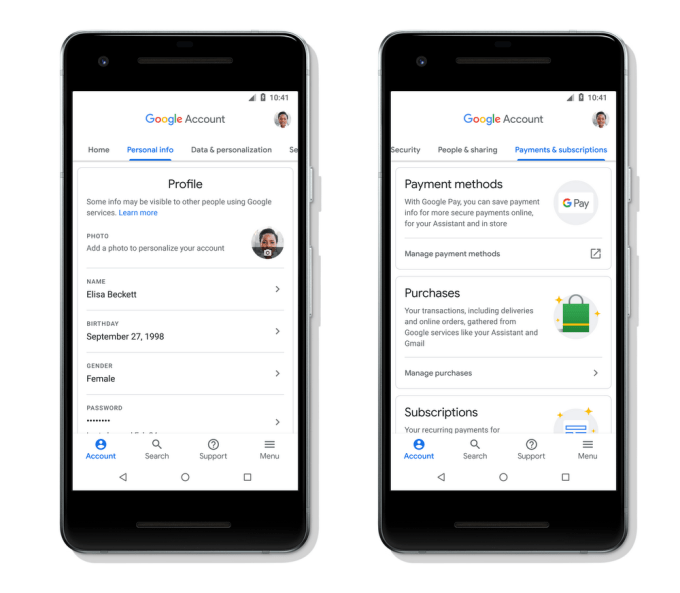Google has announced a refresh of the Google Accounts user interface. The changes are intended to make it easier for users to navigate settings and review data the company has associated with an account — including information relating to devices, payment methods, purchases, subscriptions, reservations, contacts and other personal info.
The update also makes security and privacy options more prominent, according to Google.
“To help you better understand and take control of your Google Account, we’ve made all your privacy options easy to review with our new intuitive, user-tested design,” it writes. “You can now more easily find your Activity controls in the Data & Personalization tab and choose what types of activity data are saved in your account to make Google work better for you.
“There, you’ll also find the recently updated Privacy Checkup that helps you review your privacy settings and explains how they shape your experience across Google services.”
Android users will get the refreshed Google Account interface first, with iOS and web coming later this year.

Last September the company also refreshed Google Dashboard — to make it easier to use and better integrate it into other privacy controls.
While in October it outed a revamped Security Checkup feature, offering an overview of account security that includes personalized recommendations. The same month it also launched a free, opt-in program aimed at users who believe their accounts to be at particularly high risk of targeted online attacks.
And in January it announced new ad settings controls, also billed as boosting transparency and control. So settings related updates have been coming pretty thick and fast from the ad targeting tech giant.
The latest refresh comes at a time when many companies have been rethinking their approach to security and privacy as a result of a major update to the European Union’s data protection framework which applies to entities processing EU people’s data regardless of where that data is being crunched.
Google also announced a raft of changes to its privacy policy as a direct compliance response with GDPR back in May — saying it was making the policy clearer and easier to navigate, and adding more detail and explanations. It also updated user controls at that time, simplifying on/off switches for things like location data collection and web and app activity.
So that legal imperative to increase visibility and user controls at the core of digital empires looks to be generating uplift that’s helping to raise the settings bar across entire product suites. Which is good news for users.
As well as rethinking how Google Account settings are laid out, the updated “experience” adds some new functions intended to make it easier for people to find the settings they’re looking for too.
Notably a new search functionality for locating settings or specific info within an account — such as how to change a password. Which sounds like a really handy addition. There’s also a new dedicated support section offering help with common tasks, and answers from community experts.
And while it’s certainly welcome to see a search expert like Google adding a search feature to help people gain more control over their personal data, you do have to wonder what took it so long to come up with that idea.
Controls are only as useful as they are easy to use, of course. And offering impenetrable and/or bafflingly complex settings has, shamefully, been the historical playbook of the tech industry — as a socially engineered pathway to maximize data gathering via obfuscation (and obtain consent by confusion).
Again, the GDPR makes egregious personal data heists untenable over the long term — at least where the regulation has jurisdiction.
And while built-in opacity around technology system operation is something regulators are really only beginning to get to grips with — and much important work remains to be done to put vital guardrails in place, such as around the use of personal data for political ad targeting, for instance, or to ensure AI blackboxes can’t bake in bias — several major privacy scandals have knocked the sheen off big tech’s algorithmic Pandora’s boxes in recent years. And politicians are leaning into the techlash.
So, much like all these freshly redesigned settings menus, the direction of regulatory travel looks pretty clear — even if the pace of progress is never as disruptive as the technologies themselves.
Read Full Article
No comments:
Post a Comment